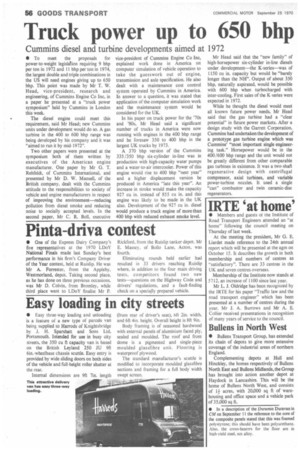Truck power up to 650 bhp
Page 58

If you've noticed an error in this article please click here to report it so we can fix it.
Cummins diesel and turbine developments aimed at 1972
• To meet the proposals for power-to-weight legislation requiring 9 bhp per ton in 1972 and 11 bhp per ton in 1974, the largest double and triple combinations in the US will need engines giving up to 650 bhp. This point was made by Mr T. W. Head, vice-president, research and engineering, of Cummins Engine Co Inc, in a paper he presented at a "truck power symposium" held by Cummins in London this week.
The diesel engine could meet this requirement, said Mr Head; new Cummins units under development would do so. A gas turbine in the 400 to 600 bhp range was being developed by his company and it was "aimed to run it by mid-1972".
Two other papers were presented at the symposium both of them written by executives of the American engine manufacturer. One paper by Mr G. T. Rehfeldt, of Cummins International, and presented by Mr D. W. Mansell, of the British company, dealt with the Cummins attitude to the responsibilities to society of vehicle and engine manufacturers in respect of improving the environment—reducing pollution from diesel smoke and reducing noise to socially accepted levels. In the second paper, Mr C. R. Boll, executive vice-president of Cummins Engine Co Inc, explained work done in America on computer simulation of vehicle operation to take the guesswork out of engine, transmission and axle specification. He also dealt with a maintenance cost control system operated by Cummins in America. In answer to a question, it was stated that application of the computer simulation work and the maintenance system would be considered for the UK.
In his paper on truck power for the '70s and '80s, Mr Head said a significant number of trucks in America were now running with engines in the 400 bhp range and he foresaw 350 to 400 bhp in the largest UK trucks by 1973.
A 370 bhp version of the Cummins 335 /350 bhp six-cylinder in-line was in production with high-capacity water pumps and a water-to-air intercooler. Power of this engine would rise to 400 bhp "next year" and a higher displacement version be produced in America "late this year". An increase in stroke would make the capacity 927 cu in. instead of 855 cu in. and this engine was likely to be made in the UK also. Development of the 927 cu in. diesel would produce a truck engine of more than 400 bhp with reduced exhaust smoke level. Mr Head said that the "new family" of high-horsepower six-cylinder in-line diesels under development—the K-series—was of 1150 cu in. capacity but would be "barely longer than the NH". Output of about 350 bhp, naturally aspirated, would be possible with 600 bhp when turbocharged with inter-cooling. First sales of the K-series were expected in 1972.
While he thought the diesel would meet all known future power needs, Mr Head said that the gas turbine had a "clear potential" in future power markets. After a design study with the Garrett Corporation, Cummins had undertaken the development of a prototype gas turbine engine which was Cummins' "most important single engineering task." Horsepower would be in the 400/600 bhp range and the unit would not be greatly different from other comparable gas turbines in existence. It was a two-shaft regenerative design with centrifugal compressor, axial turbines, and variable power-turbine nozzles. It used a single "can" combustor and twin ceramic-disc regenerators.


























































































































































































